Decandling my cork bark black pine was a straightforward process this year. I removed the spring growth and thinned unnecessary needles. I did not decandle weak shoots or shoots that grew in areas I’m trying to develop – mostly the lower branches on the right side. Here is the tree before decandling.

Cork bark Japanese black pine – June 2011
Most branches produce a single new shoot – strong areas produce two or more new shoots.
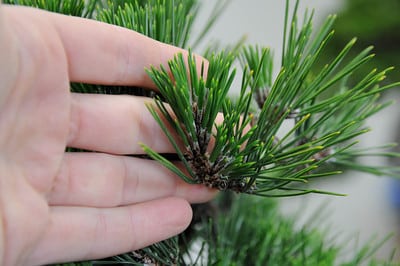
Two new shoots – this branch is strong
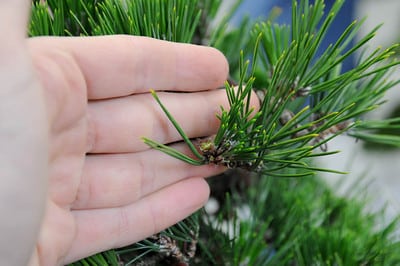
Main shoot removed – one shoot remains
When two or more shoots appear on a single branch, I remove all new shoots to prevent the branch from becoming even stronger. These branches usually have a main shoot that grows upward and one or more side shoots that grow at angles. I cut all shoots perpendicular to the direction in which they grow. Cutting two or more shoots at the same time produces uneven cuts that can lead to uneven growth.
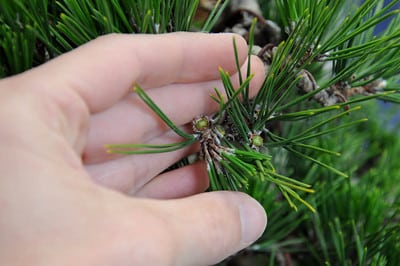
The weaker shoot grows at an angle

Both shoots removed – both cuts square
As I worked, I found a needle that was green toward the base and brown toward the tip. I likely broke it when I wired the tree in April. My goal is to break as few needles as possible when I work on pines. Lots of broken needles is a common sign of careless work.
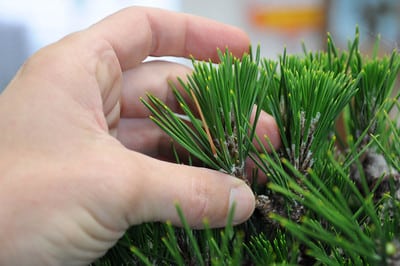
Oh my, a broken needle!
After removing the new shoots, I thinned unnecessary needles. This allows more light to reach the lower branches and helps balance vigor. I leave more needles on weak branches and fewer needles on stronger branches.
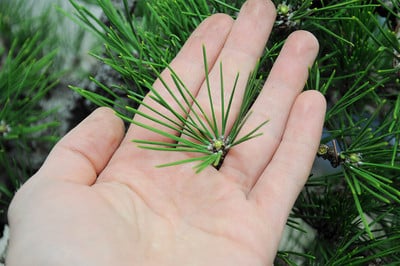
Shoot after decandling – plenty of needles
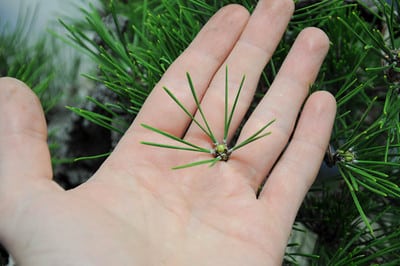
Branch thinned to five pairs of needles
When I’d finished this work, I noticed that the tree looked different than it did last year – a good sign. If all goes well, I’ll have the silhouette I’m trying to develop in a few more years.
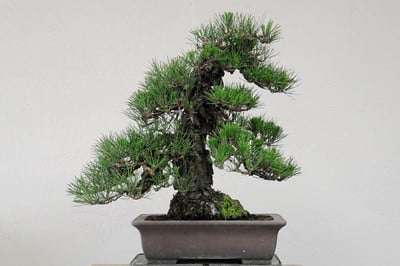
Decandling and needle thinning complete
Part of the improvement is due to improved branch structure. You can get an idea of what the branches look like below.
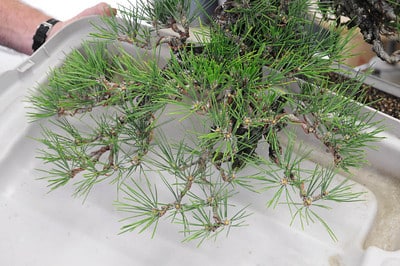
First branch on the left
Each large branch is comprised of a number of smaller branches. The subtle differences between these branches provides depth and interest.
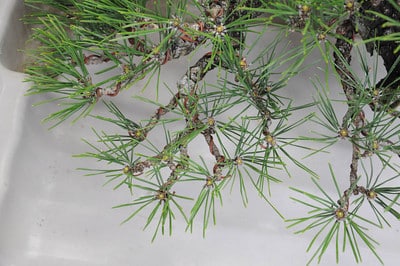
One of the branches that comprises the large first branch
For comparison’s sake, see the tree when last decandled one year ago: “Decandling cork bark Japanese black pine“
Subscribe to Bonsai Tonight
New Posts Delivered Every Tuesday and Friday
Daniel Dolan says
Jonas:
Beautiful tree….according to many of our members here in Chicago JBP do not flourish here and our Chicago Botanic Garden Collection lost another last year.
My question today relates to accessing older posts on your site.
Is there an index….or is the only way to get to previous posts in Bonsai Development, for example, to click repeatedly on Older Posts?
Thank you.
As it is mid june do you think decandling my 2 needle pines [Scots] here in Chicago is OK now? We had a 3 week late spring.
xwires says
Hi Daniel – it surprises me to hear that black pine have proved tricky in your area. As for decandling Scots or black pine, I’d likely shoot for mid to late June and then check the results in fall and make adjustments the following year. I’d start on the late side if the tree is healthy and the growth vigorous, and on the early side if the tree is less healthy. And if the late spring has delayed the spring shoots, i.e. if the spring growth is not fully mature, I’d consider delaying decandling by a week or two. I mentioned some of the related considerations here.
As for finding back content – I don’t know of a good index content on the site. The best way to browse all “development” posts is the method you described. To browse posts on a topic, I’d recommend browsing by tags, and to see all posts that mention a topic, I’d recommend the search bar. To browse posts tagged with “decandling,” you can use the following formula: http://bonsaitonight.com/tag/decandling/
Alex V says
Jonas- The silhouette of that tree is really coming along. It will be stunning when it is totally filled in.
gaycarboys says
I’ve read book on this and have been shown once or twice but I still can’t get a handle on when to take of the candles, and what to leave and ditto for the needles. I get some quite good growth but it all needed thinning. I got some new trees from the nursery as advanced stock but thought I’d be away for the root pruning and repotting season. It turns out that I’m not going to be away after all but they are doing OK a few weeks after surgery. Only the atlas cedar seems to have spat the dummy. I’ve taken the brown needles from it and there seem still lots of growth so maybe it’s OK after all. I’m slowly working my way through the older post:) Our seasons are the opposite of yours I assume so hopefully I’ve not made a pigs breakfast of it all.